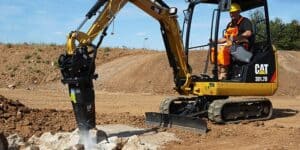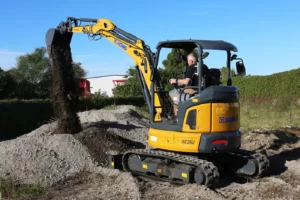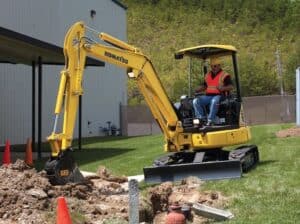How to Measure the Rubber Track Size for Your Mini Excavator
Mini excavator advantages:
The mini excavator comes into play when the need for a piece of compact construction equipment arises. A mini excavator can make your most difficult mid-sized projects a breeze that’s why most contractors choose the help of mini excavators. This heavy construction equipment was designed with the comfort of the operator in mind. New and advanced models of mini excavators are now being equipped with more comfort features like heat and air conditioning, a bigger cab space, and a wider seat. A mini excavator can turn 360 degrees and has reduced tail swing which makes it ideal to work more productively in narrow or confined spaces. These features provide operators with the benefit of more maneuverability. There are various attachments available for the mini excavator which allows the operator to complete multiple tasks using one machine. For example drilling holes with an auger, creating trenches, demolishing concrete, and many more. Each mini excavator model provides slightly different features and benefits, so it’s important to pick the right one according to your need. In this blog, we will discuss how to measure the rubber track size for your mini excavator.
Mini excavator’s rubber tracks:
Rubber tracks of mini excavators are embedded with one of the following.
- Continuous steel cords
- Non-continuous steel cords
- Continuous steel belt
- Continuous nylon belt
Most mini excavators use steel core rubber tracks. Steel core rubber tracks utilize a rubber outer core with embedded steel plates and cables. The steel plates protrude from the inner center of the rubber to make up the drive lugs. Steel core rubber tracks either have continuous steel cords or non-continuous steel cords embedded inside of the rubber.
Continuous steel cords:
Continuous steel cords form an ongoing loop that is not spliced or connected at the end with a single joint. Rubber tracks that utilize this type of steel cord technology are stronger because these cords are less prone to snapping when they are twisted and stretched.
Non-continuous steel cords:
Non-continuous steel cords inside of the mini excavator’s steel core rubber tracks have a single joint that connects the cords at the end. Over time the joint is stretched and can become weak causing the non-continuous cord to be more prone to snapping.
Continuous nylon belts:
Some models of Cat mini excavators use tracks that are not embedded with steel referred to as non-metal core tracks. These types of tracks use continuous nylon belts which can tear very easily.
Continuous steel belt:
It’s another type of rubber track option on the market that utilizes a continuous steel belt. This type of rubber track is the strongest option because unlike the continuous steel cords which have gaps in between the cords. The continuous steel belt is just one sheet of steel. These types of rubber tracks are only being manufactured by McLaren. Whether you’re using a mini excavator with rubber tracks that are embedded with continuous steel or non-continuous steel cords, belts, or nylon the way you measure the rubber track size stays the same.
Measuring the rubber track size:
If you don’t see the rubber track size stamped onto the underside of your mini excavator’s tracks then you can use these simple steps to measure the track size. Before we get into those steps first let’s discuss and understand a few key related key terms which will help you to understand exactly what you’re measuring. Rubber track manufacturers created an industry-standard or a formula that is used while measuring the size of your mini excavator’s rubber tracks. The formula is Width x Pitch x Links. Now let’s move on to how it’s done.
Rubber track width:
Width is actually measuring how wide your rubber track is from one side to the other. To measure the width of your track place the measuring tap across the top of the rubber track and note the size. Width size will always be shown in millimeters (mm).
Rubber track pitch:
Pitch is the measurement from the center of one lug to the center of the next lug. Place your tape measure on the center of one of your lugs and measure the distance from the center of that drive lug to the center of the drive lug next to it. This measurement is taken from the inside of the track. This measurement will also always be shown in millimeters.
Rubber track links:
Track link measurement is actually the total number of drive lugs on the inside of your rubber track. The total number of drive lugs or links can be measured by marking one link and then counting each link around the total circumference of the track until you come back around to the link that was marked. Once you have all of these three measurements, you’ll exactly know the size of your mini excavator’s rubber track. The reading looks something like 180x72x37. In this reading, the width is 180mm, and the pitch of rubber tracks is 72 mm, with 37 drive lugs or links.
Indications of wear and tear on rubber tracks:
It’s very important and crucial to replace the rubber tracks of your mini excavator at the first sign of potentially unsafe wear and tear. This can reduce the amount of downtime and maximize the productivity of your machine. In case you’re not sure whether your excavator needs the replacement of rubber tracks or not then you can follow these signs of wear and tear.
Tread Depth:
A brand-new rubber track typically has a tread depth of 1 inch deep. If the tracks are about halfway worn out then the tread depth will be hardly 3/8 of an inch. It can also be noticed that raised portion of the tread is flattening or are no longer visible.
Cracks:
The exterior of the rubber tracks is susceptible to cracks because of their usage on rough and rocky terrains. If there are multiple exterior cracks on the rubber tracks of the mini excavator then these should be replaced.
Track tension:
After a certain time, period rubber tracks get stretched and you may notice the lack of tension on your rubber tracks or the rubber track is jumping off the undercarriage. It’s recommended to check the track tension every five days. To check tension lift the track frame off the ground and you may see sag between the track roller and the top of the track lug. Rectifying the issue by tightening the tracks against the instructions of the manufacturer is not a good practice. Replacing the tracks is a rather more rational decision.
Lugs:
While working with debris it’s pretty much on the cards that lugs become damaged and come out because sprockets continuously slip against them. If you observe that lugs are missing then it’s a good indicator that you should replace your tracks.
Why rubber tracks are important?
Rubber tracks are a smart choice for contractors who are working on job sites with a terrain that requires a lot of traction such as dirt, mud, and slopes. Using rubber tracks increases the flotation of the mini excavator as a result of reduced ground pressure and a more even distribution of machine weight, allowing the mini excavator to effortlessly float over the soft terrain. Machines running on rubber tracks work very well on hard abrasive surfaces like concrete because unlike steel tracks, rubber tracks will not tear up those surfaces. Rubber tracks basically suppress the vibration to minimize the stress on undercarriage parts slowing wear and preventing damage. Good quality rubber tracks can easily improve productivity and increase the longevity of your mini excavator.
Why rubber tracks are better than steel tracks?
Both steel and rubber tracks are available in the market and can be used for mini excavators. Each of them has its advantages and disadvantages. You can use them for different applications depending on the stage of your project. Rubber tracks have a lot more versatility and benefits particularly if you want to work on harsh terrain and sensitive surface.
Benefits of rubber tracks:
Traction:
Rubber tracks offer greater traction on most surfaces as compared to steel tracks. Apart from offering higher intrinsic traction, they also meld well to uneven surfaces. It shows that rubber tracks have an edge if you intend to use them on a relatively smooth and dry surface. Rubber tracks can work better on concrete and asphalt without damaging or wearing. This is something that steel tracks fail to offer because they are much harder and heavier. Steel tracks are suitable for harsher terrains and environments because they have better traction and hold on such surfaces. So you can use rubber tracks for a construction project which is in the later stage of development. With rubber track mini-excavators you can access job sites that are associated with existing pavement or finished landscaping.
Durability:
Although steel tracks are known for their durability you can extend the service life of rubber tracks by using them properly. Steel tracks can be physically resistant to harsh environmental materials and have a low risk of experiencing damage to chemicals. Such chemicals and materials on the job site can damage or dissolve the rubber so you need to figure out the best areas where you can use rubber tracks. Through proper maintenance like checking and adjusting tensions and cleaning they properly can extend the life of the mini excavator’s rubber tracks.
Comfort:
There is no doubt that rubber tracks flex and conform to various types of terrains. This means that you can have peace of mind knowing that you will be a lot more comfortable while operating your mini excavator. Unlike rubber tracks, you will find that steel tracks usually cause a lot more jarring which can be tiring for you as an operator. This is not enough; these steel tracks can be loud which can be bothersome to some staff working on site, though it can also act as a warning to passersby that heavy equipment is being operated. Sometimes it can be challenging to choose the right tracks for your mini excavator. In most cases, rubber tracks and steel tracks can perform the same job with the same quality and efficiency so choosing between them is depended on the circumstances of your projects. If you’re working on a relatively smooth, dry, or wet surface then the benefits of rubber tracks are unquestionable. However, once you buy and install the rubber tracks make sure that you use and maintain them regularly.
Minimum ground damage:
As a client, the least you would want to incur regarding costs is renovating your beautiful surrounding, particularly characterized by cabro paving which was unnecessarily defaced by moving excavators conducting some assigned earthworks on a nearby space. Unlike steel tracks, rubber tracks don’t damage the ground as they tend to move more swiftly on various surfaces.
Enhanced operational capabilities:
Rubber tracks not only provide better traction on various surfaces but also come with superior mobility on rugged terrain. They offer a large surface area for ground contact which evenly distributes the weight of the excavator providing more stability which lets the excavator seamlessly glide over dilapidated terrains such as muddy surfaces without getting stuck.
Convenient for speedy operations:
Speed is an essential part because every assigned work needed to be completed within the set deadlines. On the same note-taking considerable spans to complete the anticipated earthworks present a win-win situation for both contractor and the client. Unlike heavy steel trucks or the less flexible excavators fitted with tires, rubber-tired excavators can make faster multiple trips on a given site.
Easy to install so minimized downtimes:
The efforts of enhanced operational capabilities and speedy motions associated with a rubber-tracked mini excavator can all be watered by prolonged downtimes in case there is a need for replacement of the tracks. Here is the good news! Rubber tracks are easy to install, as well as, take off. With the right installation kit, worn-out tracks can be removed and new ones put onto the mini excavator within a few minutes. This means that in case of downtime, your mini excavator will be up and running within the shortest time possible.





